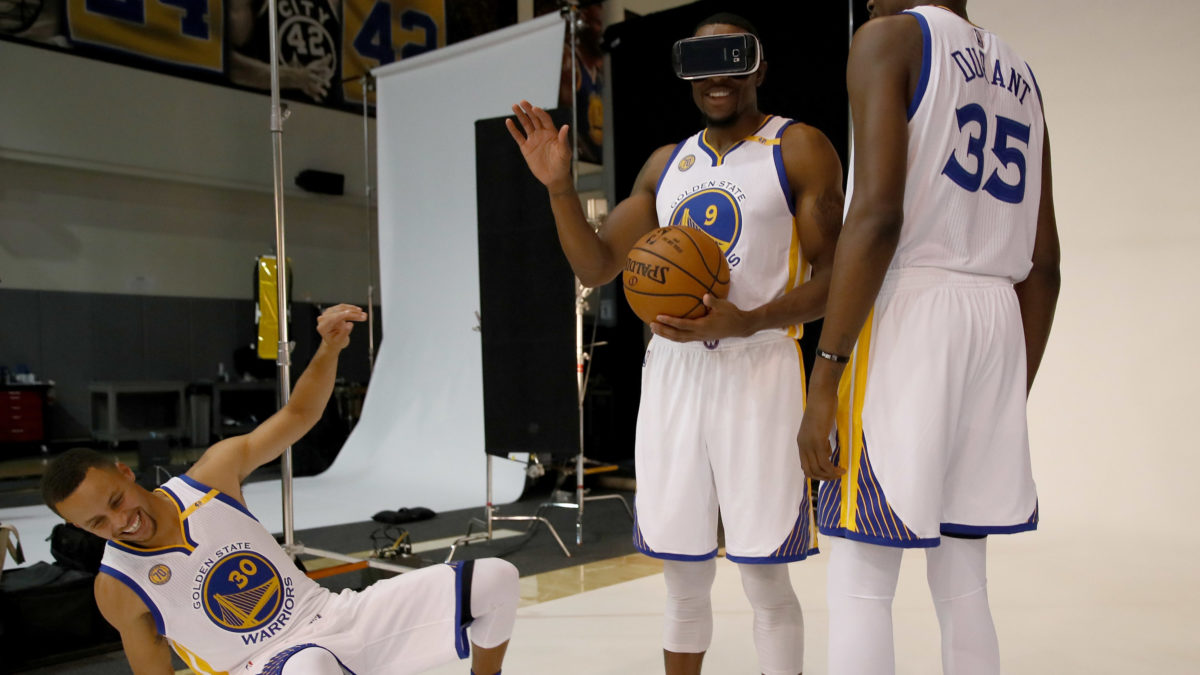Golden State Warriors teammates Kevin Durant, Stephen Curry and Andre Iguodala play around with virtual reality. (Photo by Ezra Shaw/Getty Images)
Diving into virtual worlds while exercising might help to reduce pain and allow people to sustain workouts for a longer period of time, a new study shows.
The research, led by Maria Matsangidou, a Ph.D. candidate at the Kent University School of Engineering and Digital Arts in the U.K., set out to determine whether the subjective component of pain could be minimized if the brain were busy elsewhere in a virtual setting.
The study analyzed 80 people—21 men and 59 women with an average age of 23 years—as they performed isometric bicep exercises. First, they were asked to stand with their backs straight against the wall, with their elbows and wrist joints at a 180-degree angle. They were then asked to bicep curl a dumbbell through a full range of motion. Weight was added until the participant was no longer able to perform a the full rotation.
After a 10-minute rest, participants were then directed to sit on a chair, with a yoga mat placed under the elbow for comfort. They were then asked to hold their arm in a stead position for as long as possible. This time, split into two groups, both were asked to use 20 percent of the maximum weight they could lift, holding steady for as long as possible. The headset-free group performed the task in a plain room, while the second group’s participants were given Samsung Gear virtual reality headsets that reflected a visual representation of the room, including a virtual arm and weight.
Measuring heart rate and time to exhaustion, the researchers were able to rank each participant based on pain intensity, perceived exhaustion, and private body consciousness (PBC), which measures how aware one is of internal bodily sensations.
Researchers found that the virtual reality group had “significantly lower pain and effort,” and exhibited a longer time to exhaustion compared with the control group. After one minute, the VR group had 10 percent lower pain intensity.
Another interesting component of this study was the role PBC played. In previous studies, people with a higher PBC score tended to report greater frequency and intensity of pain symptoms compared with those who had lower PBC scores. In this study, PBC had no effect on the results, suggesting virtual reality could help reduce the negative sensations of exercise regardless of a person’s level of body awareness.
The idea, said Matsangidou in her report, is that the brain is preoccupied while in virtual reality, thus distracting it from the potential pain caused by exercise.
“One possibility is that VR reduces the amount of attention that is allocated to the sensory signal of pain,” Matsangidou said in the report. “Our attentional resources are limited and to cope with the vast array of information that gets registered by our senses at any given point in time, we must select only the information that is relevant to our goal and ignore the rest. VR provides the senses of the user with a multitude of information while at the same time prevents access to his/her body. This allows the user to be immersed in the virtual environment and disconnect from the actual surroundings. As a result, attentional resources may be diverted away from the pain signal, reducing thus the experience of pain.”
Another possibility is that the cartoonish display helps reduce anxiety, thus redirecting a person’s attention from the pain signal. And yet another is that the headset user is completely embodied by the VR experience and perceives the virtual hand as their actual hand, but conceals visual stimuli, such as popping veins, that could have been seen as signals of pain and exertion.
SportTechie Takeaway
Virtual reality is already being adopting in professional sports as a means for training. Some companies, such as Strivr, have developed technologies that enable athletes to rack up virtual reps. The Dallas Cowboys, for example, use virtual reality in the offseason, while the U.S. Ski and Snowboard team used virtual reality to familiarize themselves with actual runs in Pyeongchang, South Korea ahead of the 2018 Winter Olympic Games. Last week, Boston Bruins right winger David Pastrňák announced an investment in Sense Arena, which enables ice hockey players to get reps from home.
This study might encourage more athletes and fitness enthusiasts to use virtual reality while they exercise—not to just rack up reps, but to actually reduce their pain and extend their workouts. Virtual reality games are already starting to appear in fitness centers after cardio equipment maker Life Fitness unveiled a VR fitness gaming platform last November with VirZOOM, and Matsangidou said she can imagine how this might benefit the at-home fitness world as well.
Virtual reality can “contribute to the alteration of time perception, the reduction of pain, and hence the increase of the perceived duration of the painful process,” she said. “These findings open possibilities of investigating the use of VR technology for improving immersion and interest and reducing negative exercise-associated sensations during home based exercise training.”
Source: Virtual Reality Could Reduce Pain During Exercise, Extend Workouts













